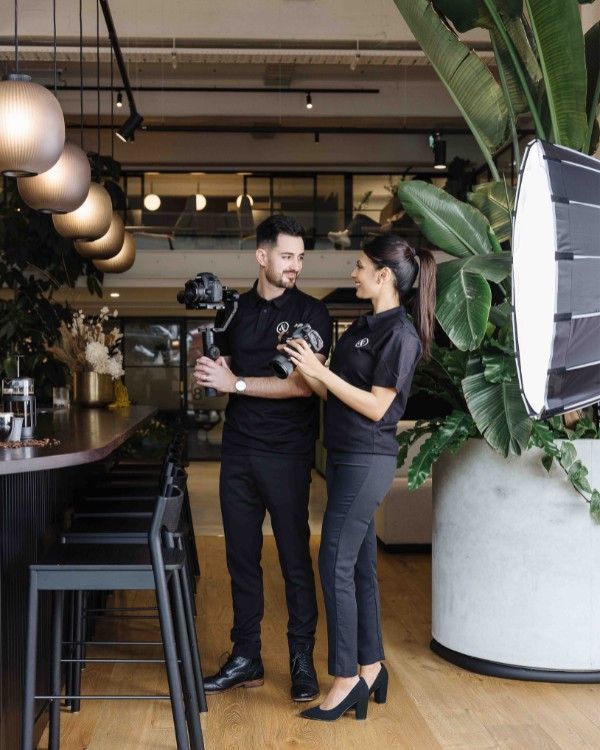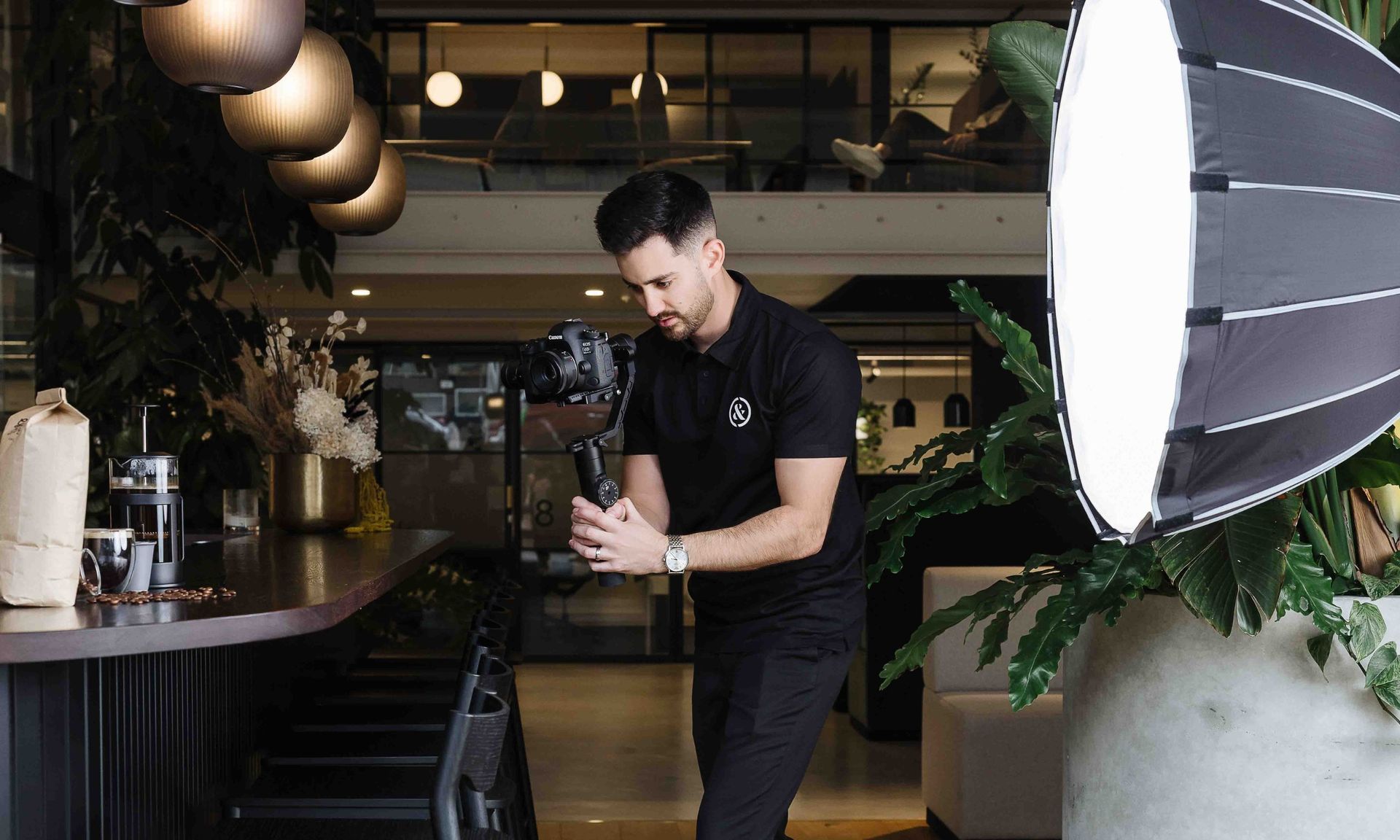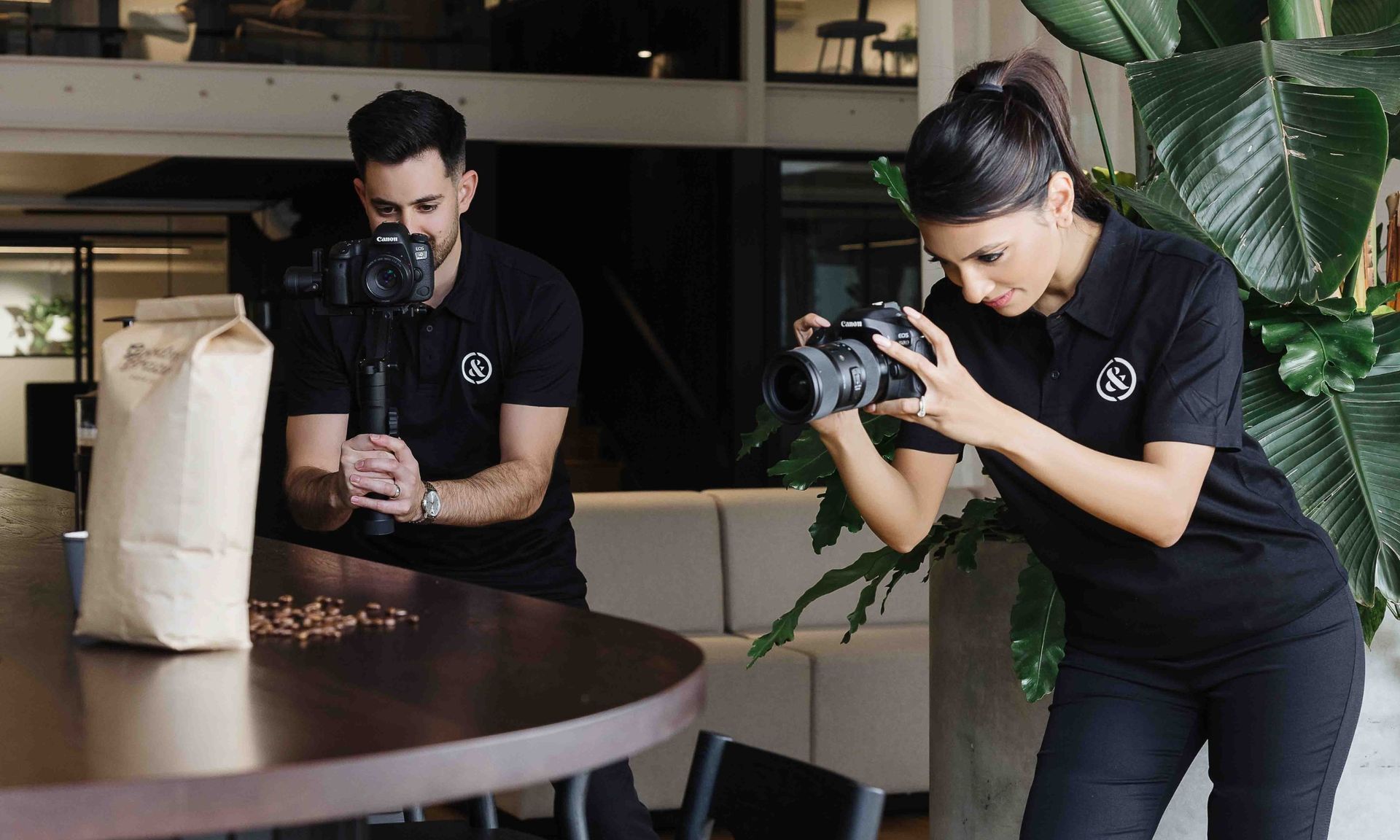The complete guide to video marketing for SMBs: Strategy, formats, platforms, and results
The complete guide to video marketing for SMBs
Strategy, formats, platforms, and results
Video has become one of the most effective ways for small and medium-sized businesses to communicate clearly, build trust, and support customer decisions. It offers a direct, visual way to show who you are, what you offer, and why people should choose your business.
Whether you're introducing your services, sharing a customer story, or explaining how something works, video allows you to connect with your audience in a format that’s engaging and easy to understand. When used strategically, it can increase visibility, improve conversion rates, and strengthen your brand.
ARTICLE CONTENTS
What this article will cover
This guide brings together the essential elements of video marketing for SMBs. Covering formats, planning, distribution, and results, so you can create content with purpose and confidence.
What is video marketing?
This section introduces the purpose of video marketing and explains why it’s such a powerful tool for small and medium-sized businesses.
Why video content performs better than text or images
A look at why video captures attention, builds credibility, and delivers stronger results across platforms.
How long should your marketing videos be?
Guidance on video lengths for different platforms, goals, and stages of the customer journey.
The 8 most effective types of videos for small businesses
A breakdown of the most useful video formats and how each one supports different marketing outcomes.
How to plan and shoot your first business video
Simple, practical steps to help you create your first video with clarity and confidence.
Behind-the-scenes videos that build trust
Why informal, everyday clips help humanise your brand and strengthen customer connection.
Using video in email marketing campaigns
Tips for using video in emails without running into technical issues or deliverability problems.
Where and how to share your videos for maximum reach
Smart distribution tactics to help your video content reach the right people in the right places.
Common video marketing mistakes to avoid
The most frequent errors SMBs make with video and how to avoid them for better results
What is video marketing?
Video is one of the most effective ways to help people understand what your business offers and why it matters. It brings your message to life in a way that feels clear, direct, and easy to connect with.
A way to connect, explain, and build trust
Video marketing is the use of video to promote your services, explain what you do, and build stronger connections with your audience. It goes beyond showing a product or listing features. It brings your business to life through visuals, voice, and story. For small and medium-sized businesses, it’s one of the most effective ways to communicate clearly, gain trust, and support people in making decisions.
It’s accessible to any business
You don’t need to be a big brand with a studio budget. In fact, many SMBs find success by keeping it simple, real, and human. Whether it’s a short introduction, a customer story, or a walkthrough of your service, each video gives people a reason to stop, watch, and remember your business. Used well, it becomes a practical tool that supports everything from visibility and lead generation to long-term brand credibility.
Video shows what words can’t
What sets video apart is its ability to show rather than tell. A potential customer might scroll past written content, but a video can capture their attention in seconds. They can hear your tone, see your team in action, and understand what it’s like to work with you. That level of visibility matters, especially in industries where personal trust plays a role in the buying process.
How audience behaviour is shifting
Audience expectations have changed. More people choose to watch rather than read, especially when they're deciding who to trust or what to buy. For small businesses, this presents a real opportunity to connect in a more direct and memorable way. A clear, authentic video can do more than explain your service. It can shape how your business is remembered.
Curious about how video marketing could work for your business?
We’re here to help you explore your options and find the right place to start.
Why video content performs better than text or images
Video is one of the most engaging forms of content. It’s more effective than text because the brain processes visuals faster and retains the message more easily, making video a powerful tool for engagement (Forbes, 2017).
(01)
Video holds attention in ways that static content often can’t. The brain processes visuals faster than text, which means a well-structured video can get your message across within seconds. This matters when users are scrolling quickly or comparing multiple providers. A short video showing who you are or how your service works can be more impactful than paragraphs of written content.
It captures attention quickly
(02)
Trust isn’t just built on what you say, it’s how you say it. Video lets people hear your voice, see your expressions, and experience your presence. These small human cues make a big difference, especially for service-based businesses where connection and credibility influence decision-making. Seeing a real person on screen makes your business feel more approachable.
Video builds trust
(03)
Whether someone is comparing services or trying to understand what makes your business different, video can help them move forward. Explainer videos, testimonials, or simple walk-throughs remove friction and answer questions in a way that’s easier to absorb. This helps your audience feel more confident, informed, and ready to take the next step.
Video supports decision-making
(04)
Video is not just more engaging, it’s also prioritised by the platforms your customers use. Social media algorithms tend to favour video content because it keeps users watching longer. The same is true for websites where video can increase time on page and reduce bounce rates. This makes video a valuable tool for both engagement and visibility.
It’s favoured by platforms and algorithms
The 8 most effective types of videos for small businesses
There’s no single video format that works for every situation. Different types of videos serve different roles in your marketing, depending on your goals, your audience, and where they are in the decision-making process. The most effective video strategies use a mix of formats to build awareness, explain value, and move people toward enquiry or purchase.
Brand story video
A brand story video helps people understand who you are, what you stand for, and why your business exists. It introduces your values, your team, and your approach in a way that feels personal and relatable. These videos work well on your homepage or About page and are especially effective in industries where trust and relationships drive decisions.
Product or service demo
Demo videos show how your service works or what a customer can expect from working with you. They’re useful for answering common questions, clarifying complex offerings, or showing your process in action. For businesses offering tailored services or detailed processes, a demo video can reduce confusion and encourage action.
Customer testimonial
Testimonial videos allow your clients to speak on your behalf. Seeing a real customer talk about their experience builds trust and makes your offer feel more credible. These are ideal for service pages, sales follow-ups, or social proof on landing pages, particularly when filmed in a way that feels genuine and unrehearsed.
Explainer video
Explainer videos are helpful when your audience needs a bit more clarity before committing. They simplify a concept or process using straightforward language, visuals, or step-by-step breakdowns. This format is especially effective for service-based businesses that want to guide potential customers through how things work.
Behind-the-scenes video
Behind-the-scenes videos offer a glimpse into your daily work, team culture, or service delivery. They show the human side of your business and can make your brand feel more approachable. These work well as informal social content, but also strengthen brand connection when added to email campaigns or website pages.
Educational or how-to video
How-to videos provide real value by helping your audience learn something useful. This format can demonstrate your expertise, build trust, and give potential customers a reason to return to your content. Think walkthroughs, practical tips, or answers to frequently asked questions that relate to your service.
Event video
If your business takes part in or hosts events, filming those moments can help showcase your brand’s personality and engagement. Event videos are perfect for social sharing, email updates, or even recruiting content. They show that your business is active, connected, and involved in your community or industry.
Video ad or commercial
A video ad is a short, targeted clip designed to promote an offer, drive clicks, or generate leads. It works best in paid campaigns across platforms like Facebook, Instagram, or YouTube. The goal here is clear messaging, strong visuals, and a direct call to action that encourages immediate response.
Need help choosing the right type of video for your business?
We’ll help you figure out what makes sense for your business, your audience and your goals, without overcomplicating it.
How long should your marketing videos be?
There’s no one-size-fits-all answer to video length. What matters most is aligning the duration with the purpose, platform, and stage of the customer journey.
Start by thinking about the purpose
The ideal video length comes down to what you're trying to achieve. Short-form videos under 60 seconds are great for brand awareness and social media, where attention spans are limited. Longer videos between two and five minutes work well when your audience already has some interest and wants more detail, such as in a product demo or testimonial.
Keep it short when you need quick attention
Short videos are most effective when the goal is to grab attention and leave a strong impression. These work well on platforms like Instagram, Facebook, and TikTok, where users expect fast, visually engaging content. Think service previews, behind-the-scenes snippets, or customer soundbites that build interest quickly.
Go longer when your audience wants more detail
When your audience is already considering your offer, a longer video can provide the clarity and confidence they need to take action. These videos are ideal for explaining processes, answering common questions, or telling a customer story in more depth. Formats like how-to videos, service walkthroughs, or detailed case studies tend to perform well on your website, in email, or on YouTube.
Match the format to where it’s being watched
Each platform has its own expectations. Social media favours shorter content, while your website or YouTube can support more depth. For email, a teaser video under 60 seconds is usually best, linking to a longer version hosted elsewhere. Matching your video length to the platform and audience intent ensures your content feels appropriate and effective.
Aim for clarity, not perfection
The most effective videos are the ones that communicate a clear message. Whether it’s 30 seconds or three minutes long, what matters most is that your content is focused, easy to follow, and relevant to your audience. A simple, well-explained concept often delivers more impact than a heavily scripted or overproduced video. If the viewer understands what you offer, why it matters, and what they should do next, the video has done its job. Don’t let production pressure slow you down, clarity and authenticity are what make videos effective, especially for small businesses building trust through consistency.
How to plan and shoot your first business video
Getting started with video can be simple. With a bit of planning and a clear message, you can create something effective that feels true to your brand and easy for your audience to engage with.
2
Use an outline, not a full script
Rather than reading from a script, jot down key points and speak naturally. This helps the video feel more relaxed and authentic.
Start with one clear message
1
Focus on a single point, such as introducing your service or answering a common question. Keeping it focused makes it easier for your audience to understand and remember.
3
Choose a quiet, well-lit space
Good lighting and clear audio make a big difference. Natural light and minimal background noise help keep the focus on your message.
Keep it short and purposeful
Aim for 30 to 90 seconds. That’s long enough to make an impression without losing attention. Include a simple call to action at the end. Remember, short and genuine is far more effective than long and rehearsed (Think with Google, 2024).
4
Behind-the-scenes videos that build trust
Behind-the-scenes videos give your audience a more personal view of your business. They’re a simple way to build trust by showing real people, real work, and the everyday moments that make your service what it is.
Behind-the-scenes content gives people a genuine look at how your business operates, helping them feel more confident in who they’re working with. These videos are a way to show the people behind the brand and the work that goes into your service. A short clip of a team member preparing for a job, setting up equipment, or explaining their role adds a layer of authenticity and credibility. It gives viewers a better sense of who you are and how you work, which can be especially important in industries where personal trust and professionalism matter.
What makes these videos effective is their simplicity. Rather than relying on formal scripts or structured messaging, they offer an honest glimpse into your day-to-day. A clear and relevant moment, such as part of your process, a team update, or something in progress, helps make your brand feel approachable. When shared regularly across your website, emails, or social channels, behind-the-scenes content builds familiarity over time and reinforces the values behind your business.
Using video in email marketing campaigns
Adding video to your email marketing can significantly increase engagement. It’s a simple way to make your content more visual, more personal, and more likely to prompt action.
Use video to make your message more engaging
When someone receives an email, you only have a few seconds to capture their attention. A short, relevant video can instantly shift the tone from generic to personal. Whether you’re introducing your team, highlighting a recent project, or answering a frequently asked question, video gives people a faster way to understand your message and connect with it.
Link to the video instead of embedding it
Most email platforms don’t support embedded video playback. To avoid technical issues, use a thumbnail image or a short animated GIF as a visual cue, and link it to the full video hosted on your website or a platform like YouTube or Vimeo. This keeps the email lightweight and easy to deliver, while still encouraging people to watch.
Support your video with strong email content
Your email copy still plays an important role. Use the subject line to hint at the video content, and make sure the surrounding text is clear and purposeful. Together, the words and the video should work as one message, making the viewer feel informed and motivated to click through.
Keep it short and focused
Attention spans in inboxes are short. Videos in email should typically stay under 60 seconds and focus on a single idea. This could be a quick introduction, a service tip, or a piece of behind-the-scenes content that brings your brand to life. Ending with a simple, relevant call to action helps guide the viewer toward the next step.
Why it works
Video creates a sense of connection that static images and text often can’t achieve. It gives your brand a voice, a face, and a feeling of presence, even in a digital space. When included in the right context, it helps your message stand out and encourages more meaningful interaction with your audience.
Not sure where to start?
We can help you create simple, effective videos that work across email platforms without the technical stress. From planning to distribution, Clarke & Clarke makes it easy to integrate video into your existing campaigns.
Where and how to share your videos for maximum reach
Creating a great video is only part of the job. To make your content work harder, you need a clear distribution plan. Video marketing isn’t just about visibility, it’s about using the right format to reach the right audience in the right place (Park University). Where you share your video, and how you adapt it to suit each platform, will determine how many people see it, how they engage with it, and what action they take.
Use your website to support conversion
Your website is one of the best places to host key videos. A short introduction or testimonial video on your homepage, About page, or service pages can increase time on site and help build trust. If someone is already exploring your site, they are likely further along in their decision-making. A well-placed video can be the prompt they need to enquire or take the next step.
Match the format to the platform
Different platforms call for different approaches. Instagram and TikTok favour short, vertical videos that catch attention quickly. Facebook supports a wider range of lengths and formats, especially when paired with captions. YouTube works well for more detailed content such as how-to videos, service explanations, or longer brand stories. Make sure your video is formatted, captioned, and optimised for the environment it will appear in.
Don’t overlook email and newsletters
Your email list is made up of people who have already shown interest in your business. Including short, relevant videos in your newsletters or follow-ups can help you reconnect and keep your audience engaged. Even a 30-second update or behind-the-scenes clip can make an email feel more personal and useful.
Keep social media consistent
Sharing videos regularly on your social channels helps build familiarity over time. You do not need to post everywhere at once. Instead, choose one or two platforms where your audience is most active and share content that reflects your brand voice and service style. Consistency matters more than quantity. Showing up regularly with thoughtful content builds momentum.
Use video in paid campaigns to drive leads
Video can be especially effective in paid advertising. A short, well-targeted video ad can increase click-through rates and drive more qualified traffic to your website. These videos should be clear, direct, and aligned with a specific offer or goal. Platforms like Google Ads, Meta Ads and YouTube provide strong targeting tools to help your video reach the right people at the right time.
Make it easy to share
Encourage others to share your content by making it accessible. Include video links in your email signature, post them on your Google Business Profile, and ask happy customers if they are comfortable sharing testimonials. The more places your video appears, the more likely it is to reach new potential clients.
Track performance and refine
Use analytics to monitor how your videos are performing across different channels. Metrics like views, watch time, click-throughs, and enquiries can tell you which formats and platforms are working best. Over time, this helps you refine your content strategy and focus on what delivers results.
Common video marketing mistakes to avoid
Video might look effortless when it’s polished and professional, but that result comes from planning. When businesses rush into filming without structure, they often end up with confusing messaging, missed points, or content that runs far too long. Planning isn’t about overcomplicating things, it’s about making sure your message lands clearly and with impact.
Trying to say too much at once
When a video tries to cover everything, the core message gets lost. Each video should have a single focus, whether it's introducing your service, sharing a testimonial, or explaining a process. Keeping it clear and specific makes it easier for your audience to follow and remember.
Overlooking the audience’s perspective
It’s easy to create content from your own point of view, but effective videos speak to what your audience needs to see, hear, or understand. Ask yourself what questions your customer might have and what would help them feel more confident in choosing you.
Not planning where the video will live
A strong video with no distribution strategy won’t go far. Consider where each video will be used before you film. Content created for a service page might need a different tone or structure than something shared on Instagram or used in a sales follow-up.
Inconsistent posting or messaging
One video is a start, but consistency is what builds recognition and trust. Videos should reflect your brand style, tone, and purpose. Even if the content is simple, regular updates help keep your business visible and top of mind.
Not measuring what works
Skipping over analytics means missing opportunities to improve. Watching views is helpful, but metrics like watch time, click-through rates, and enquiries give better insight into how your audience is engaging. These signals can guide future video topics, formats, and placements.
Want a deeper look at where things often go wrong?
Conclusion
Video marketing gives small and medium-sized businesses a clear way to build trust, communicate and connect with their audience, and stand out in a competitive market. It helps you show what you do, who you are, and why someone should choose your service in a way that’s visual, direct, and easy to understand.
Whether it’s a short intro clip, a testimonial, or a behind-the-scenes moment, the right video can help people understand what you do and why they should choose your business.
Throughout this guide, we’ve covered what video marketing is, why it works, how long your content should be, the types of videos that perform well, and where to share them for the best results. You don’t need a big production team, what matters most is clarity, consistency, and showing up in a way that feels real.
Ready to use video more intentionally across your marketing?
Clarke & Clarke can help you plan, create, and distribute content that align with your brand and your business goals. We’ll help you turn ideas into content that is thoughtful, effective, easy to share, and built to drive results.
Frequently asked questions
Still have questions? Here are a few common ones we hear from businesses getting started with video marketing.
What kind of videos should I create first?
Start with simple, useful content like a welcome message, client testimonial, or a short explainer about your services. These are great for building trust and answering common questions.
How long should my videos be for different platforms?
Read moreFor social media, aim for 15 to 60 seconds. Website and email videos can range from 60 seconds to three minutes, while YouTube allows for longer formats if you're sharing detailed content.
Can I use the same video on multiple platforms?
Yes, but it helps to adjust the format or message slightly for each one. A short horizontal video may work on YouTube, while a cropped vertical version might be better for Instagram, Youtube Shorts or TikTok.
Do I need to appear on camera in every video?
Not necessarily, while being on camera can help build trust, you can still create effective videos using voice overs, on-screen text, or visuals of your work. The most important thing is that the content feels clear, genuine, and aligned with your brand.
How do I know if my videos are working?
Look at metrics that match your goals. Views and watch time show reach, while click-throughs and enquiries reflect engagement. Over time, these numbers help you see what’s working and where to improve.
Do I need professional help to create marketing videos?
Not always, you can start with simple videos filmed on a phone, as long as they’re clear and purposeful. But if you want support with planning, editing, or creating content that fits across platforms, working with a team like Clarke & Clarke can make the process easier and more strategic.

















